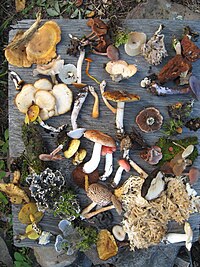
Photo from wikipedia
BACKGROUND Traditional Chongqing radish paocai fermented with aged brine is considered to have the most intense flavor and authentic taste. Eight 'Yanzhi' (red, RRPB group) and 'Chunbulao' (white, WRPB) radish… Click to show full abstract
BACKGROUND Traditional Chongqing radish paocai fermented with aged brine is considered to have the most intense flavor and authentic taste. Eight 'Yanzhi' (red, RRPB group) and 'Chunbulao' (white, WRPB) radish paocai brine samples were collected from Chongqing peasant households, and the diversity and community structures of bacteria present in these brines were determined using PacBio single-molecule real-time sequencing of their full-length 16S rRNA genes. RESULTS In total, 30 phyla, 218 genera, and 306 species were identified from the RRPB group, with 20 phyla, 261 genera, and 420 species present in the WRPB group. Obvious differences in bacterial profiles between the RRPB and WRPB groups were found, with the bacterial diversity of the WRPB group shown to be greater than that of the RRPB group. This study revealed several characteristics of the bacteria composition, including the predominance of heterofermentative lactic acid bacteria, the species diversity of genus Pseudomonas, and the presence of three opportunistic pathogenic species. CONCLUSION This study provides detailed information on the bacterial diversity and community structure of Chongqing radish paocai brine samples, and suggests it may be necessary to analyze paocai brine for potential sources of bacterial contamination and take appropriate measures to exclude any pathogenic species. © 2018 Society of Chemical Industry.
Journal Title: Journal of the science of food and agriculture
Year Published: 2018
Link to full text (if available)
Share on Social Media: Sign Up to like & get
recommendations!